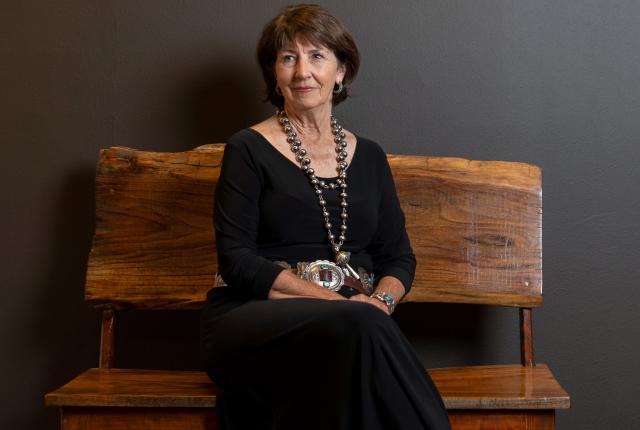EXCITEMENT OVERTOOK MARY ANN CORTESE as she watched the first display go up in the empty Treaty Room at the Bosque Redondo Memorial at Fort Sumner Historic Site. The larger-than-life photograph featured Barboncito, a Diné spiritual and political leader who in the 1860s attempted to save his people from forced relocation by the U.S. Army—a grueling journey on foot from their Diné Bikéyah homeland in the Four Corners region to Hwéeldi (a Diné word for “suffering place”).
Hundreds died during the 300-mile trek to Bosque Redondo, known as the Long Walk. Thousands more Navajo and Mescalero Apache people didn’t survive the four years of captivity they then endured before the Navajo Nation and the United States signed a peace treaty, allowing them to return home.
“The first few designs for the exhibit were not correct,” recalls Cortese, a Fort Sumner resident and president of the Friends of the Bosque Redondo Memorial. “There was very little Native involvement in them. The story was coming from the military and the white man’s story.”
That all changed thanks to Cortese, the late John McMillan (who served as principal at the local high school where Cortese worked as a teacher), and others from the Friends of the Bosque Redondo Memorial.
The push for a new exhibit began in 1990, when a group of Diné students visited Fort Sumner and wrote a pointed letter asking why their people’s story wasn’t included in the displays. Inspired by their words, Cortese, McMillan, and other local educators formed a planning committee that included Navajo and Mescalero Apache officials.
In 2005, the Bosque Redondo Memorial building at the Fort Sumner Historic Site opened, fulfilling McMillan’s dream shortly before he passed away. “On his deathbed, he called Mary Ann to the hospital and made her promise that she would continue her work with this memorial,” recalls fellow teacher Cathy Fikany.
“People leave stories here. We cry a lot. But they’re so affirming because the people were so strong.”
That year, the memorial was designated an international Site of Conscience. It took 17 more years of planning, organizing, and developing for the new permanent exhibit, Bosque Redondo: A Place of Suffering … A Place of Survival, to open over the 2022 Memorial Day weekend.
It includes historical photographs, oral histories in Diné (Navajo), Ndé (Apache), and English, and interactive displays on topics ranging from efforts at assimilation to conditions during the Long Walk. On the ceiling are 10,000 lights, one to honor each soul who was held at Bosque Redondo. At the end of the exhibit, a comfortable room invites reflection and input from those who visit.
“People leave stories here,” says Cortese. “We cry a lot. But they’re so affirming because the people were so strong.”
At the grand opening, Cortese met two sisters whose great-great-grandmother had been pregnant during the Long Walk. “When she got home, she died, but the child lived,” one of the women told her. “Two Navajo women took turns breastfeeding this baby so she could live.” That little girl was their great-grandmother. “That’s why they had come to see the place,” Cortese says.
Others will, too, Fikany predicts. “It has a global impact,” she says of the memorial. “Only in telling the truth about history can healing begin.”
TRUE HEROES
Read more about the individuals who went above and beyond to support our communities.


